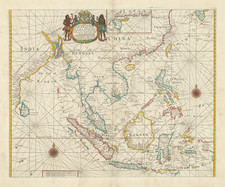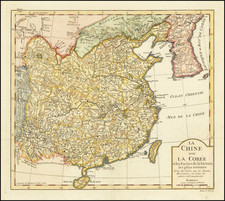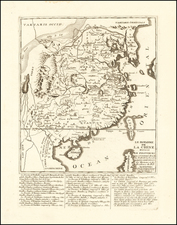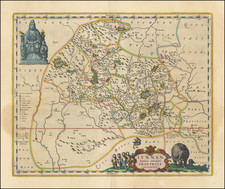Early Missionary Map of Canton (Guangzhou), Published in Canton in the First Major Journal of Sinology
Fine woodblock map of Canton showing the city’s street plan, waterways, and important buildings and sites. The plan was based on a Chinese map and offered Western readers a glimpse of the city then forbidden to Western travelers.
The woodblock print portrays the city’s street plan, defensive walls and forts, and bodies of water in a stylized but clear way using thin black lines. The map’s title, “City and Suburbs of Canton” is printed in English in the top left-hand corner. Seventy-eight temples, represented as small, stylized houses, dot the map along with several two-dimensionally-rendered important buildings like the Zhenhai Tower, the Grand Mosque, the Dutch and French Follies, and the Thirteen Foreign Factories. Otherwise, ornamentation is sparse, limited to some suburban vegetation and mountains.
This plan of the city of Canton appeared in 1834 in The Chinese Repository (1832-1851). Published in Canton, it had the distinction of being the first major journal of Sinology. It was based on a well-regarded Chinese map "executed,” in the words of the journal’s editor, “by a native hand—we dare not say artist."
The editor’s goal was to give readers of The Chinese Repository, mostly Protestant missionaries, a picture of the city of Canton at a time when the Qing state barred Westerners from venturing beyond the confines of their small enclave in the southwest of the city (marked b. on the map). Despite the editor’s disparaging of the mapmaker’s artistry, the map is a well-executed representation of Canton’s Old Town, New Town, and surroundings as they were in the early nineteenth century.
It is clear that the purpose of this large-scale topological city plan was not practical use, but rather to introduce the viewer to Canton’s general layout. Instead of Chinese characters, superimposed on the Chinese map are seventeen Roman letters, added by the editor of The Chinese Repository, which correspond to sixteen places of interest, listed separately in the journal (vol. II, pg. 160).
a. These letters mark the situation of the Choo keäng, or Pearl river. A small fort, called the French folly, stands in the river a short distance from the southeast corner of the city; another fort, called the Dutch folly, stands further up the river: a little higher up are ledges of rocks, which at low water are seen above the surface. Beyond the foreign factories westward, several small canals branch off into the suburbs; but for a mile or two the river itself is nearly straight.
b. This letter points out on the map the situation of the foreign factories on the north bank of the river.
c. This letter marks the locality of the Mohammedan mosque, in the old city near the western gate; it stands erect, and not inclined as represented on the map.
d. A native pagoda. This stands north of the mosque, or Mohammedan pagoda, as it has often been called.
e. A lofty and conspicuous building called the five-storied pagoda; it stands on the north side of the city.
f. The governor's house; it stands in the new city not far from the Yew-lan gate.
g. The fooyuen's house, which stands near the centre of the old city.
h. House of the tseangkenn or Tartar general; this is also in the old city, and not far from the two pagodas.
i, The house of the hoppo; it is situated on the south side of the new city, a few rods east of the Tsing-hae gate.
k. House of the heŏ-yuen, or literary chancellor of Canton; it is in the south part of the old city.
I. House of the pooching sze, or treasurer of the provincial revenue, near the centre of the old city.
m. House of the ganchă sze, or criminal judge of the province, near the house of the literary chancellor.
n. The house of the yen-yun sze., or superintendent of the salt department; it stands near the Kwei-tih gate.
o. Kung-yuen; a hall for the reception of literary candidates at the regular examinations; it stands near the southeast corner of the old city.
p. Yuh-ying-ting; a foundling hospital, on the east of the city, about half a mile from the walls.
q. Teën-tsze ma-taon; the execution ground; without the southern gates, near the river.
The underlying Chinese map
As the editor of The Chinese Repository notes, “City and Suburbs of Canton” is a “facsimile of one of the best native maps.” The original native map does not seem to have survived, though a nearly exact copy, titled “The Complete Map of the Provincial Capital Guangzhou [广州省城全图]” and containing the Chinese characters removed from “City and Suburbs of Canton,” was included the 1835 Gazetteer of Nanhai Country [南海县志]. The Chinese map underlying “City and Suburbs of Canton” belongs to the genre of maps created for local gazetteers, periodical publications that combined local history, geography, biography as references for officials and scholars.
The pre-Opium War historical moment
Published just five years before the outbreak of the First Opium War, an event that marks for many Chinese the beginning of a “Century of Humiliation,” “City and Suburbs of Canton” contains many hints of this fascinating but fleeting historical moment. The cosmopolitanism, power and wealth of pre-war Guangzhou, which had been China’s premier entrepôt on the South China Sea since the Song Dynasty, are evident in the map’s portrayal of a mosque, Cantonese temples and pagodas, and the Manchu government headquarters inside of strong fortifications, with the relatively small foreign enclave outside the walls.
Marked a. and b. are the Pearl River and the Foreign Factories, the only places that were accessible to the map’s intended viewers. An understanding of the rest of Guangzhou, a city of nearly one million in the early nineteenth century, was left to the imagination of the missionaries and traders crowded into their enclaves. The map’s purpose was to give a more accurate and definite shape to readers’ imaginings of Guangzhou.
The inaccessibility of Guangzhou to foreigners is what made possible the unusual synthesis of “City and Suburbs of Canton,” with its Chinese-style map and Roman lettering. Within a decade of its publication, the balance of power between the Qing Empire and the Western powers had shifted, and Western mapmakers were able to produce maps of Chinese cities according to Western cartographic conventions. Hence, “City and Suburbs of Canton” represents the closing of an age of Chinese-foreign interactions in China’s great South China Seas port city.













![[English Edition!] Chinae, olim Sinarum regionis nova descriptio. auctore Ludouico Georgio.](https://storage.googleapis.com/raremaps/img/small/71123.jpg)
